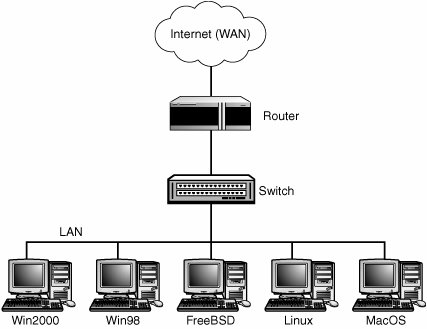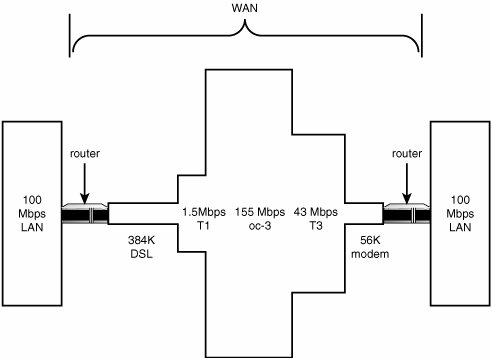Network Topologies
| Your FreeBSD machine might be installed on a university network, in a professional colocation facility, within a corporate enterprise network, or on a home dial-up network (or dialed-up directly). These are just the most common types of settings. Different network topologies, or logical layouts of devices and data link mechanisms, are as numerous as the individual networks in the worldno two are exactly the same. However, virtually all networks share a common basic topology and a few fundamental components. In Figure 22.2, you can see the type of topology that would be found in a typical home network. The topology shown here is also serviceable as a simplified diagram of an enterprise or university network. Figure 22.2. A basic network topology, showing a WAN and a LAN, separated by a router and comprising a number of different types of computers. These WAN link types are designed to run over very long distances. Because of their serial nature, they can carry traffic over the same fiber-optic infrastructure that carries standard telephone network "trunk" traffic. In fact, data traffic over these lines is indistinguishable from digital voice traffic; it's treated exactly the same way by phone switching equipment and travels from one geographical location to another the same way a phone call would. Another type of network topology is the, which involves a primary network like the one shown in Figure 22.2. This architecture also includes a secondary WAN that connects the network to a large number of home users dialing up via modems and phone lines. This is illustrated in Figure 22.3. Figure 22.3. The ISP network architecture; home users dial up through the telephone WAN over modems to the ISP's LAN, which then connects to the Internet WAN. After the WAN traffic reaches a DSU/CSU (which interfaces the phone company's transmission lines with your network's serial infrastructure) and router, however, it makes the transition to LAN transport mechanisms, such as Ethernet. These are physical link mechanisms that, unlike serial WAN traffic, can interface directly with any computer equipped with an Ethernet card. Figure 22.4 shows a diagram of the bandwidth capacity of the entire path from one LAN to another. This is the path that Internet traffic usually takes from a server (such as a website) to a client (a user's web browser). The WAN pipe, as a rule, is narrowest right before it hits the LAN router. Figure 22.4. A schematic diagram of bandwidth availability throughout the path from one LAN (at the server end) to another LAN (at the client end), via a WAN of varying capacity. Notice that although traffic in the middle of the WAN travels over lines with vastly more bandwidth than even the fastest LAN wiring, this bandwidth is divided among a great many more users than a typical LAN. Thousands, even millions of users share the thickest trunk lines during peak WAN usage periods. There are seldom more than a few hundred users competing for usage of a LAN. |


